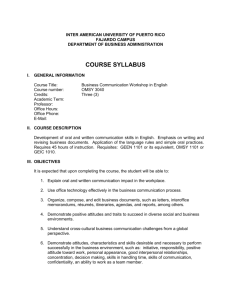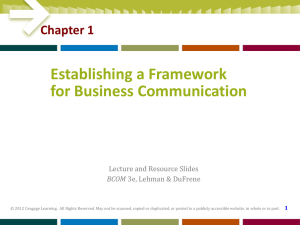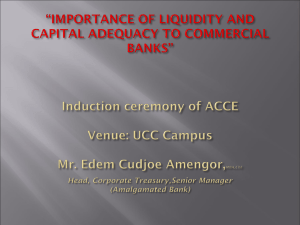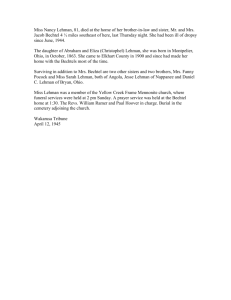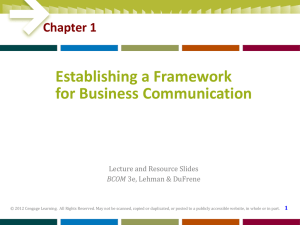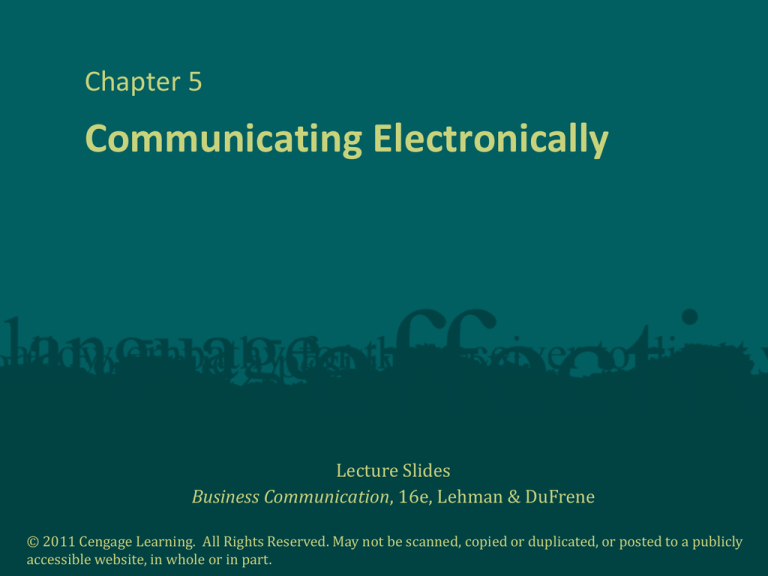
Chapter 5
Communicating Electronically
Lecture Slides
Business Communication, 16e, Lehman & DuFrene
© 2011 Cengage Learning. All Rights Reserved. May not be scanned, copied or duplicated, or posted to a publicly
accessible website, in whole or in part.
Your Turn
Explain why you agree or disagree with the
following statement:
“No one in my company writes
anymore. We just send emails and
make phone calls.”
Chapter 5, Business Communication, 16e, Lehman & DuFrene
© 2011
Cengage Learning
Guidelines for Preparing
Email Messages
• Provide a useful ________
subject line
• Limit the message to single ______
topic directed
toward __________
receiver’s needs
• Organize
_________ based on reader reaction
• Use _______,
jargon technical words, and shortened
terms selectively
readability
• Use graphic highlighting for better ___________
• _______emails
for clarity, conciseness, and tone
Revise
Chapter 5, Business Communication, 16e, Lehman & DuFrene
© 2011
Cengage Learning
Netiquette Fundamentals
• Check email ________
promptly
• Do not contribute to email ________
overload
• Use email for appropriate messages
– Send _____,
_____ messages
short direct
– Do not send messages when you are
_____
angry
• Beware of email hoaxes
______ and _______
viruses
• Develop email organizational
____________ habits
Chapter 5, Business Communication, 16e, Lehman & DuFrene
© 2011
Cengage Learning
Instant Messaging
Advantages
• Real-time, simple group
communication
• Instantaneous exchange of
graphics and files
• Cost-effective medium for
internal and external
communication
• Informal medium with more
attention on message than on
grammar/spelling
Chapter 5, Business Communication, 16e, Lehman & DuFrene
Disadvantages
• Security and virus prone
• Computer access required
• Potential nonwork use on the
job
• Danger of false identity and
eavesdropping
• Too informal for some
messages and audiences
© 2011
Cengage Learning
Text Messaging
• Is used more for social communication than
as a business tool
• Frequently serves as a superficial greeting,
such as a nod or wave
• Requires even more conciseness than instant
messaging
• Is more informal and abbreviated than email
Chapter 5, Business Communication, 16e, Lehman & DuFrene
© 2011
Cengage Learning
Electronic Messages and the Law
• Assume responsibility for commitments made
via email, as printouts serve as verification
• Abide by copyright laws (use of graphics,
message forwarding . . .)
• Be familiar with laws that affect technology:
— Electronic Communications Privacy Act —allows
companies to monitor email usage for legitimate
business purposes
Chapter 5, Business Communication, 16e, Lehman & DuFrene
© 2011
Cengage Learning
Types of Web Presence
Intranet
• Distributes information to
employees at various locations
• Requires password
Extranet
• Shares information among
partners at various locations
• Requires password
Public Web
Presence
• Available to anyone, anytime
Chapter 5, Business Communication, 16e, Lehman & DuFrene
© 2011
Cengage Learning
Writing for the Web
•
•
•
•
•
•
Be brief and keep it simple
Consider appropriate jargon
Use eye-catching headlines
Break longer documents into small chunks
Use attention-getting devices judiciously
Avoid placing critical information in graphic
form only
• Assure accessibility by users with disabilities
Chapter 5, Business Communication, 16e, Lehman & DuFrene
© 2011
Cengage Learning
Wikis for Business
• Allows anyone to modify content on a common
website in real-time
• Encourages free exchange of evolving
information
• Should not be considered content authoritative
• Requires appropriate writing style:
– Avoid first-person blogging style
– Present factual information in clear, concise, and neutral
language
Chapter 5, Business Communication, 16e, Lehman & DuFrene
© 2011
Cengage Learning
Blogs for Business
• Are dynamic, with rapidly changing content
• Can be searchable for useful archives
• Are usually publicly available
• Need current information for the specific
target audience
Chapter 5, Business Communication, 16e, Lehman & DuFrene
© 2011
Cengage Learning
Making a Professional
Impression with Voice Mail
• Review greetings and messages before
saving
• Rerecord when necessary
• Script messages before recording to
shorten time
• Stand, smile, and visualize receiver when
recording
Chapter 5, Business Communication, 16e, Lehman & DuFrene
© 2011
Cengage Learning
Cell Phone Communication
• Observe wireless-free quiet zones
• Respect others in public places by using
conversational tone and message discretion
• Place safety above phone usage while
driving
• Choose a secure communication channel
for sending confidential or sensitive
information
Chapter 5, Business Communication, 16e, Lehman & DuFrene
© 2011
Cengage Learning
Your Turn
How do you decide which technology
might be appropriate for communicating a
particular message to an individual or
group?
Chapter 5, Business Communication, 16e, Lehman & DuFrene
© 2011
Cengage Learning


